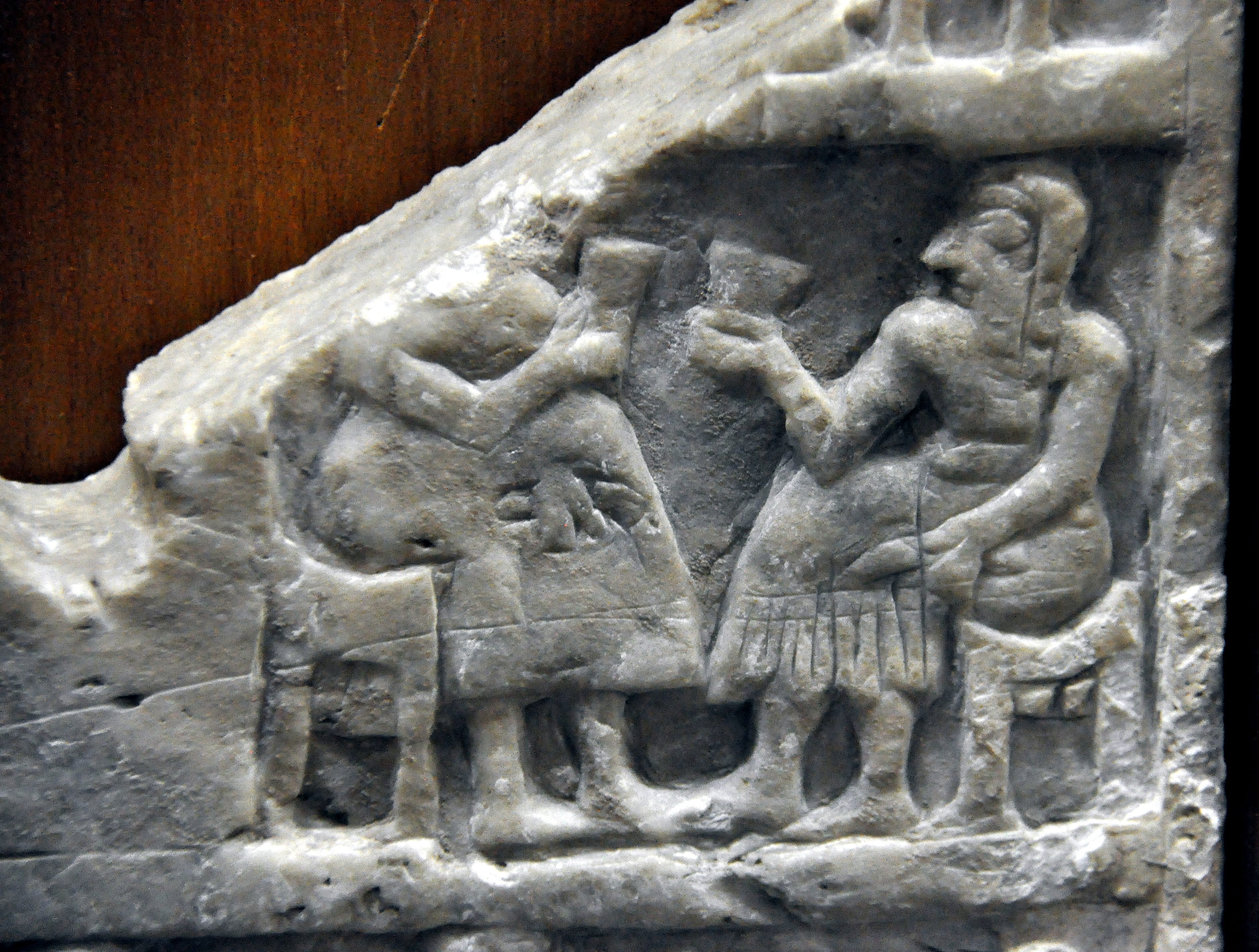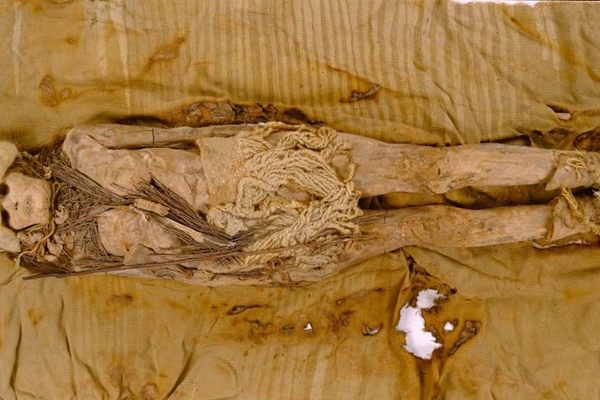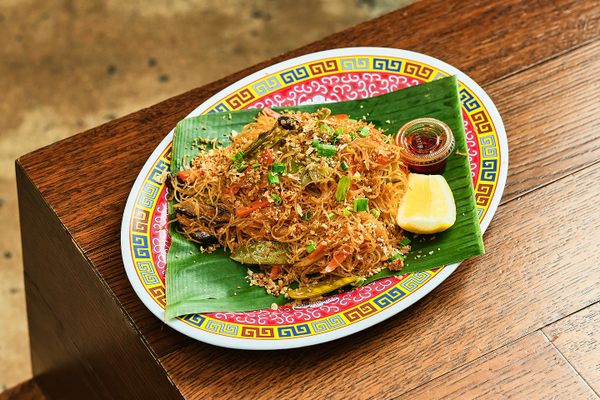Ordering Off a 5,000-Year-Old Mesopotamian Menu
A community effort brings ancient flavors to modern Texas.
Among the campus buildings at Rice University in Houston, Texas, one curious structure stands out. The first feature you’ll probably notice is that it’s made of reeds; but these are not just any reeds. They arrived inside a 40-foot shipping container, harvested and partly assembled by master artisans in the marshlands of southern Iraq, where structures like this one have been made for centuries. It’s called a mudhif, and for Iraq’s Marsh Arab ethnic minority, it’s a traditional village meetinghouse where disputes are settled and important gatherings are held. On November 5, Rice University’s mudhif will host a gathering like no other: a feast inspired by the cuisine of ancient Mesopotamia and informed by new archaeological findings from the region that the Marsh Arabs call home.
Built between June and September 2023, the Texas mudhif was a project years in the making. It represents a collaborative effort between local organizations led by the Arab-American Educational Foundation and Archaeology Now, the Houston-based affiliate of the Archaeological Institute of America. “Archaeology and now together are sort of oxymorons, but we deliberately intended that,” says Archaeology Now director Becky Lao. “We are who we are today because of who we were.” For Lao, archaeology provides a powerful form of storytelling that connects diverse groups of people both past and present, and this includes the archaeology of food. “Food is a way to access,” she says. “And it’s a way to meet, and a way to destroy stereotypes and cultivate understanding.”
In this case, the food of the ancient world presents an opportunity to connect Houstoners with the endangered culture of the modern Marsh Arabs. While the Marsh Arabs have accepted and adapted to new influences over time, their traditional way of life—centered around fishing and agriculture, and facilitated by canoes and reed-built structures like the mudhif—has remained basically unchanged for millennia. “Archaeologically, we think it’s almost a mirror image of the ancient Sumerians,” who inhabited southern Iraq as far back as 6,000 years ago, says Zaid Alrawi, an archaeologist affiliated with the University of Pennsylvania who served as a consultant on the Mesopotamian dinner.

Since the late 20th century, southern Iraq’s ancient Mesopotamian Marshes, formerly extensive, have been greatly reduced by climate change and intentional draining under Saddam Hussein. Many of the people who depended on the land have had to relocate, including to Houston, which now hosts a diaspora community of Marsh Arabs who have been involved with the mudhif project from its inception.
Alrawi describes the dinner as a way “to complete the setting” of the mudhif by paying homage to the structure’s ancient origins. Rather than modern Iraqi food, the dinner menu is based on recent archaeological discoveries from Lagash. Located in modern-day southern Iraq, Lagash was a major Sumerian city home to some 100,000 people in the third millennium BC. In 2022, a University of Pennsylvania excavation led by Alrawi made a remarkable discovery that shed new light on how and what Lagash’s inhabitants ate.
Near a pottery manufacturing area in Lagash dated to around 2700 BC, archaeologists discovered a large open space. It featured a huge hearth—too large to belong to a home—with ash deposits from frequent cooking. There were also numerous bowls and pottery vessels in the space, some piled for storage and some discarded in trash heaps with food remains, including, Alrawi notes, “bones, and specifically fish bones.” Lao calls the discarded pottery “the Styrofoam of its day,” cheaply-produced single-use vessels that were meant to be disposed of.
Also found in this space were mudbrick benches and a large pottery vessel embedded into the ground inside another container, with broken potsherds filling the space between them. “It seems like this was some kind of refrigerating device,” Alrawi explains. If this were the case, food would have been stored below-ground within the inner vessel, and the insulating layer of pottery would have helped maintain a cooler temperature. With all of these indicators, the interpretation was clear: This was a restaurant, though Alrawi points out that it wasn’t the kind of place you’d go for a relaxing atmosphere. “The distance between the manufacturing area and the tavern is not far at all,” Alrawi notes, “and I think it was placed there purposely to accommodate the workers.” Lao identifies the Lagash tavern as “the company cafeteria,” catering to large numbers of pottery workers on their lunch break.

The discovery of the Lagash workers’ tavern has played a major role in shaping the menu of the Houston mudhif dinner, which is not intended to represent a kingly feast, but what Lao calls “a working-man’s meal” in Mesopotamia. Alrawi notes that just as the Marsh Arab lifestyle has changed in some ways but remained unchanged as its core, so has the Iraqi diet. New ingredients have arrived in Iraq since the days of Mesopotamia, but “river fish and bread,” Alrawi says, “basically have always been available.” These two foundational elements will be central to the menu of the historical dinner.
At the Lagash tavern, archaeologists also found a round grill for cooking whole fish spatchcocked into a flat, circular shape—a preparation style still popular in Iraq under the name of masgouf, sometimes considered the country’s national dish. Bread for the Lagash pottery workers was baked in round clay pit ovens, similar to the tanur or tandoor still used not only in Iraq, but across much of Asia today. Many other things on the menu in ancient Lagash are still eaten in Iraq as well, like olives, figs, dates, and stone fruits. But at the time the tavern was in operation, ingredients like tomatoes, peppers, and rice had not yet found their way to the region, and wheat was just starting to be domesticated. Instead, the central grain was barley, used to make both bread and another Mesopotamian staple that the team in Houston set their sights on recreating: beer.
“We’re baking the bread with a crusty outside and a soft interior to preserve the yeast,” says Lao. This half-cooked barley loaf containing active yeast cultures was used as a fermentation starter in Mesopotamia, according to a recipe found in the “Hymn to Ninkasi,” goddess of brewing, dated to at least 1800 BC. The starter bread was combined with malted (sprouted and roasted) grain, water, and spices for flavoring, then fermented for about one week. “The shelf life is very short, maybe a day or two at the most,” Lao explains. “So [Mesopotamians] were doing this on the regular because this was the primary thing that they drank.” The end result has a sour flavor and a low alcohol content, and more resembles a lumpy porridge than our smooth modern brews; Mesopotamians drank it through straws made from the same reeds as the mudhif.

“Whenever you put an archaeologist together with a chef or a brewer,” says Lao, “they feed on each other.” Recreating the Mesopotamian meal has been a team effort. Another local Houston organization, Sitta Brew Hub, has been tasked with adapting the “Hymn to Ninkasi” beer recipe for the dinner in the mudhif. To design the food menu, Archaeology Now partnered with chefs from the nutrition outreach program Bite of HOPE as well as from the local Iraqi community. They tested recipes and conducted research for about six weeks prior to the event.
Putting together a dinner based on what people ate so long ago was no easy task. The biggest challenge, according to Bite of HOPE program manager Chris Lott, is “to keep it as true to the recipe as possible.” While there are some surviving Mesopotamian written recipes, dated to around 1730 BC, “some of it hasn’t been translated,” Lott explains. “So there are some things that we don’t know what they are.” Scholars may offer drastically different translations for unknown ingredients: Samidu, which was sprinkled into soups, has been translated variously as semolina, a spice, or a type of onion. And without the background knowledge that the authors of these recipes assumed their readers would have, instructions are often frustratingly unclear.
Moreover, “three-thousand years of cultivation has changed what [crops] they were working with,” says Lott, “So what we’re eating now isn’t exactly what they had then.” And while fish was central to the diet of the workers in Lagash, the 60-plus modern guests at the dinner may expect a wider range of options. Lott explains that effort had to be made on the part of the menu developers, “so if you don’t like fish, there’s some other things that you can try” that are still within historical plausibility. Aside from masgouf fish and barley bread baked in a traditional oven, guests will be able to sample a Mesopotamian stew and a pastry-like dessert inspired by the fruit and nut confections of the Sumerians.

Alrawi paints a vivid picture of the Lagash tavern when it was in use. “The manufacturing area must have been very, very active, very messy, with all the smoke coming out,” he says, noting that there would be shifts of workers manning the fire and “constantly preparing food.” A recreated Mesopotamian meal is never going to be 100 percent historically accurate, but for Lott, it can still provide “a brief little snapshot of what was going on in that time…for people to be able to see that, and live it, just for a moment.” Archaeology Now and their collaborators hope that by tasting the food of ancient people, modern diners will have an easier time entering into their world and seeing them as the living society they once were.
Lao describes the positive response to the mudhif project from visitors of all backgrounds, but especially the Iraqi community in Houston, including those who are not Marsh Arab. “The Marsh Arabs are considered the country people of Iraq,” Lao explains. “They’re a little bit looked down on, and somebody from Baghdad would never go to the marshes…But they come to Houston, and here they’re meeting, and it’s been a revelation for everybody.” She recounts stories of Iraqi-Americans moved by the experience of seeing a traditional mudhif in an unexpected place, and being able to show their children a piece of their heritage.
Food has the power to connect us with a world as alien and faraway as third-millennium BC Lagash. In the context of the mudhif dinner, it also serves as a reminder of the incredibly ancient roots behind the present-day culture of the Marsh Arabs, and a call to not let that culture be forgotten. “Across time, we’ve always met at the table,” says Lao. Beneath the woven roof of the mudhif, the food of the distant past has brought a modern community together.
Gastro Obscura covers the world’s most wondrous food and drink.
Sign up for our regular newsletter.






























Follow us on Twitter to get the latest on the world's hidden wonders.
Like us on Facebook to get the latest on the world's hidden wonders.
Follow us on Twitter Like us on Facebook